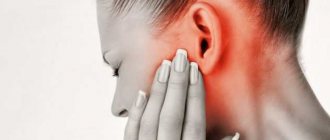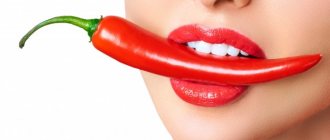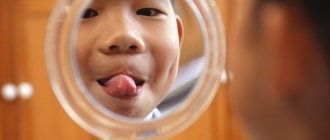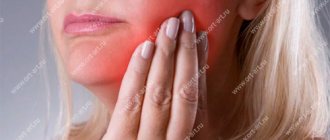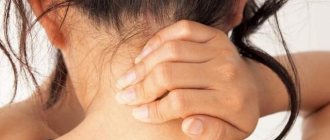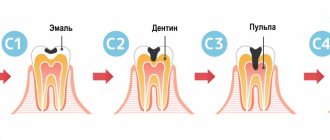Dental problems
Dental diseases
With deep caries and its complications - pulpitis, periodontitis - the pain radiates to the jaw in the area of the affected tooth.
Infectious and inflammatory processes of the soft tissues surrounding the tooth - periodontitis, abscess - cause swelling, which, by squeezing the nerve endings, provokes the appearance of painful sensations in the jaw.
With increased tooth sensitivity, eating hot, cold, spicy, sour or sweet foods and drinks, and brushing your teeth cause acute pain that spreads to the jaw.
When third premolars - wisdom teeth - emerge, complications often arise: pericoronitis, inflammation of the periosteum, one of the symptoms of which is severe pain in the jaw.
Dental treatment procedures associated with violation of tissue integrity - implantation, prosthetics, tooth extraction, installation of fillings, professional teeth cleaning and whitening - contribute to the appearance of pain in the jaw.
Bruxism
With bruxism, involuntary grinding of teeth at night significantly increases the load on the masticatory muscles, which leads to their prolonged spasm. In this case, the correct occlusion of the dentition is disrupted with the development of pain in the jaw when chewing.
Temporomandibular joint problems
If pain occurs in the jaw when opening the mouth, this is a symptom of temporomandibular joint pathology.
Pain in the projection of the jaw is often accompanied by pain in the ear, head, and face. The causes of joint dysfunction are injuries, malocclusions, incorrectly installed dentures, arthritis, arthrosis, and hypertonicity of the masticatory muscles.
Tumors of the lower jaw
Pain in the jaw area is characteristic of benign and malignant neoplasms. Benign tumors are characterized by slow growth and lack of invasion into adjacent tissues and organs.
Malignant neoplasia rapidly progresses, pain intensifies with irradiation into the eye, temporal region, ear, jaw.
What patients may complain about with diseases of the temporomandibular joint or TMJ
Clicking, crunching near the ear, namely in the projection of the temporomandibular joint (TMJ), pain in the jaw, jamming of the jaw when opening the mouth - all these are symptoms of muscular-articular dysfunction.
To find out the cause of this dysfunction, you first need to know how the joint works.
- Joint capsule
- Articular head or condyle
- Articular disc
- Articular tubercle
Where does everything come from?
Clicking is characteristic of dislocations of the articular disc, which can be anterior, posterior and lateral. The picture below shows from left to right: normal disc position, posterior dislocation, anterior dislocation. Dislocation occurs with or without reduction, i.e. with and without reduction. So, with a dislocation with reduction, you can hear two clicks: the first at the moment of opening the mouth, the second at the moment of closing.
What are the dangers of clicking in a joint? The danger lies in premature wear of the joint elements, which will lead to the development of arthritis, arthrosis and the final stage - ankylosis (complete immobility of the joint).
As for the crunching sound in the joint when the jaw moves, this sound is more characteristic of arthrosis of the TMJ. It occurs as a result of friction of deformed surfaces. The outcome of arthrosis is ankylosis or complete immobility of the joint.
Pain syndrome may often accompany TMJ arthritis, and in the projection of the joint, i.e. in front of the ear tragus there is swelling, skin hyperemia, general malaise, increased body temperature, etc. Arthritis pain is acute. Purulent inflammation in a joint can result in complete destruction of all its elements.
Also, acute pain can accompany neuralgia, anterior dislocation of the articular disc, in which the posterior condylar fusion ruptures and compression of the articular disc occurs. Dull, aching pain can occur with arthrosis, chronic arthritis and TMJ pain dysfunction syndrome (TMD).
With the development of BSD, in addition to pain in the joint area, headaches, pain and noise in the ears, and muscle tension in the occipital region are also possible.
Patients complain of difficulty opening the mouth (jaw contracture) mainly with arthrosis and sometimes with BSD. The process of jaw jamming is a different problem, and should not be confused with jaw contracture. The mechanism of wedging refers to the dislocation of the articular disc, which was discussed above. Without going into details, this can be explained this way: the articular head, under certain circumstances, does not return to its original position, because cannot overcome, for example, the posterior pole of the disc if it was in a state of dislocation. Or we are talking about dislocation of the lower jaw, when the articular head, when opening the mouth very wide, moves forward from the articular tubercle.
Distinctive features
Complaints in diseases of the TMJ should be distinguished from many other pathological processes in this area. So next to the TMJ there are: the auditory canal, the parotid salivary gland, the masticatory muscle, lymph nodes, and the corresponding pathological processes: otitis media, sialadenitis, myositis, lymphadenitis. In addition, pain can be due to neuralgia and inflammatory diseases in the skin and subcutaneous tissue (for example, with a boil). Separately, it is necessary to consider tumors of the parotid-masticatory region, benign and malignant.
As for the pathology of the oral cavity, in the form of difficult eruption of wisdom teeth or complicated dental caries, the main problem they create is limited opening of the mouth (contracture), which occurs as a result of the transfer of inflammation to the masticatory muscles. The pain in this case may also be similar, because impulses from the teeth spread along the branches of the trigeminal nerve, and the pain can radiate to the ear and temple.
Which doctor can help?
The dentist deals with this problem. The area of activity may be as follows: orthopedics, orthodontics or surgery; The main thing is that the doctor specializes in the diagnosis and treatment of TMJ pathology. Currently, such specialists are usually called gnathologists.
What if my dentist finds it difficult to make a diagnosis?
And this can happen. It is necessary to consult with related specialists: ENT doctor, neurologist, maxillofacial surgeon. If these specialists rule out their pathology, then there is only one option left. What's next? See previous paragraph.
What examination is necessary to diagnose TMJ pathology?
Unfortunately, based on complaints alone, a diagnosis cannot be made and, accordingly, treatment cannot be prescribed. An examination and sometimes additional studies are required: X-ray examination, computed tomography, electromyography, recording of movements of the lower jaw, etc.
Establishing the causes of the disease can be helped by collecting anamnesis: previous injury, any treatment (especially dental), the presence of diseases of internal organs and body systems, etc.
What can you do yourself?
If TMJ is still suspected, then the only thing you can do to help yourself is to create rest for the joint. That is, exclude solid foods, exclude chewing gum, do not open your mouth wide and do not yawn. If there is severe pain, when it is not possible to visit a doctor and there are no contraindications, use analgesics.
For complete treatment of TMJ diseases, see specialized literature.
Causes of jaw pain not related to dental disorders
Neuralgia
When the trigeminal nerve, which is responsible for the sensitivity of the face and oral cavity, is damaged, the pain is strong, sharp, reminiscent of the pain of pulpitis. Often patients with trigeminal neuralgia undergo unnecessary dental treatment with depulpation or tooth extraction, but the pain syndrome persists.
Sialolithiasis
Salivary stone disease is characterized by the formation of stones in the ducts of the large salivary glands. Since the salivary glands are located in the mouth, pain during their inflammation also affects other nearby organs of the oral cavity, in particular the jaw.
Sinusitis
When the mucous membrane of the maxillary cavity becomes inflamed, increasing swelling and accumulation of exudate cause pain spreading to the upper jaw area from the side of the affected sinus.
Otitis
Sometimes the symptoms of otitis media are similar to toothache. With inflammation of the middle ear, pain often radiates to the jaw. The pain is sharp, shooting, aggravated by chewing and swallowing.
Submandibular lymphadenopathy
Enlargement of the submandibular lymph nodes is observed in diseases of the tonsils, acute respiratory viral infections, stomatitis, and oncological tumors. Pain under the jaw is often accompanied by limited range of motion - it is difficult for the patient to bend and turn his head, or open his mouth wide.
Diseases of the cardiovascular system
Irradiation of pain into the lower jaw can be observed during an attack of angina and myocardial infarction. A characteristic symptom of coronary heart disease is burning, pressing pain behind the sternum. But with an atypical course of a heart attack, retrosternal pain may be completely absent, only reflected pain comes to the fore: in the left arm, in the neck, in the face, in the jaw.
Pain in the temple area
Pain in the temple area is one of the most common complaints with which patients turn to a neurologist. Modern research shows that more than 70% of the population of developed countries complain of episodic or chronic headaches in the temple area. However, this figure does not reflect the true state of affairs, since many patients do not go to doctors, self-medicating or not wanting to be examined. This leads to the development of dangerous side effects, namely:
- liver damage;
- kidney damage;
- allergies;
- gastrointestinal disorders.
Causes of pain in the temple area
Headaches in the temple area may be associated with impaired tone of the cerebral vessels of the arterial and venous beds. These may be symptoms:
- Autonomic dysfunction;
- migraine;
- increased intracranial pressure.
In older age, these are the initial manifestations of arterial hypertension and cerebral atherosclerosis. Provoking moments can be a change in weather, mental, emotional and physical overload. In this case, heaviness in the head and pressing, throbbing pain in the back of the head or temples are characteristic. The causes of pain in the temple area can be:
- Infectious diseases (various, including influenza, sore throat and many others);
- intoxication (that is, poisoning), the most familiar of which is alcohol;
Psychogenic headaches are “nervous” headaches, aching, dull, sensations that arise either in the temple, then in the back of the head, or somewhere inside. This increases irritability and fatigue. Patients complain of general “discomfort in the head,” which makes it difficult to gather thoughts and concentrate, plus a feeling of anxiety. Migraine and cluster pain are independent diseases, the main symptom of which is a severe acute headache covering one half of the head. At the same time, shiny dots (“spots”) appear before the eyes. Some people experience increased sensitivity to smells, tastes, and various external stimuli during an attack. Subsequently, patients complain of pain in one half of the head, pain in the temple, radiating to the eye.
If untreated, the pain spreads throughout the head, and nausea and vomiting often occur. Migraine headaches may be accompanied by photophobia and general weakness. Suffering lasts from 30 minutes to several hours. If the attack drags on for several days, it may end in a migraine stroke; In women, migraine is usually associated with the menstrual cycle and first makes itself felt during puberty, a period of hormonal storms. During pregnancy, the frequency of attacks decreases; after childbirth, migraines may go away forever. The causes of pain in the temples can be caused by the following reasons:
- Hormonal disorders during menopause;
- headaches in the temple area of unknown etiology;
- temporal arteritis.
It is worth noting that temporal arteritis is a rare disease in which inflammation of the walls of the temporal arteries occurs, causing excruciating severe throbbing pain in the temple area.
Pain in the temple area often indicates disruption of the cranial and spinal nerves. One of the most common symptoms of temporomandibular joint pathology . Typically, headaches due to pathology of the temporomandibular joint are located in the temple area, the back of the head, and even the shoulders (shoulder blades).
Jaw clenching and teeth grinding may be symptoms of temporomandibular joint disorder; these symptoms cause muscle pain , which may be the cause of headaches. A slipped TMJ disc can also cause pain in the joint, which often radiates to the temples, forehead, or neck. These headaches are often so severe that doctors mistake them and treat them as migraines or brain disorders.
Diet
Foods and drinks containing monosodium glutamate, which is a flavoring additive found in many processed foods; It is believed to be the cause of severe headaches. In addition, these foods in your daily diet can cause difficulty breathing and tension in the face and jaw. Pain occurs statistically in 10-15% of the population. Headache may appear 20-30 minutes after ingestion of glutamate . The pain is characterized by throbbing, dull and throbbing pain in the temple area and painful sensations in the forehead area. Products containing monosodium glutamate:
- Chinese cuisine;
- canned and dry soups;
- roasted nuts;
- processed meat;
- turkey in its own juice;
- gravies, sauces;
- some types of potato snacks and chips;
- spices and seasonings.
With a diet containing foods rich in nitrites , throbbing pain in the temple area may also occur. As a rule, half an hour after nitrites enter the body with the following food:
- Canned ham
- corned beef;
- hot dogs;
- salami;
- bologna;
- bacon;
- smoked fish.
Chocolate is one of the most powerful migraine triggers. Eating chocolate can provoke the development of hypoglycemia. Chocolate also contains caffeine, which can trigger migraines , and phenylethylamine in chocolate causes vasoconstriction, which leads to headaches in the temple area.
Firstly, chocolate provokes hypoglycemia because it contains sugar, and also because cocoa beans have a mild hypoglycemic effect. Secondly, chocolate contains caffeine, a migraine trigger. Thirdly, it contains finylethylamine, which, being an amine, causes vasoconstriction and, as a result, a headache in the temple area. It is best to limit your consumption of these foods if you notice these symptoms after eating them. If pain in the temple area is regular, it makes sense to seek help from a professional neurologist.
Diagnostics
When there is pain in the jaw, the patient first seeks advice from a dentist.
A dental examination includes the following steps.
- Clarifying patient complaints and collecting anamnesis. Since the main complaint is pain in the jaw, the time of its appearance (at night, during the day), the nature of the pain (sharp, dull, pulsating, aching), and duration (constant, paroxysmal) are specified.
- Examination of the oral cavity with assessment of the condition of the mucous membrane, tongue, gums, determination of the type of bite.
- Examination of the surfaces of all teeth using a probe and mirrors, identifying the integrity of the dentition, detecting defects in the hard tissues of the teeth.
- The percussion method is used to determine caries complications.
- Thermodiagnostics is used to identify pain reactions.
